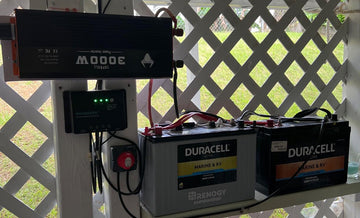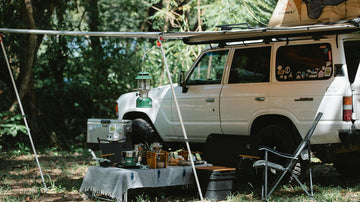The RV lifestyle has always appealed to lovers of freedom and adventure, but the reality is that there are challenges and hassles to face. Want to enjoy the same comforts at home while exploring the outdoors? Off-grid power is an excellent way to do so. An RV inverter with just the right amount of power can increase your freedom on the road and keep you comfortably off the grid. Therefore, you need to know what size inverter you need for your RV.
What does the RV inverter do
As you know, most appliances use 120 volts AC, just like in your home, the power you get from the main grid. When the motorhome is away from shore power, it can only be powered by batteries or solar panels. RV batteries and solar panels typically run on 12V DC, which can power most of the lights and appliances in your RV. However, it cannot run higher-power appliances, so to power electronic devices such as fans, coffee makers, microwaves, laptops, etc., you will need to convert the DC power to AC power.
An RV inverter is a device that converts the direct current (DC) generated by your battery or solar panels into alternating current (AC), which is key to the operation of your RV's electrical system. With an inverter, you have more flexibility and freedom to camp off-grid or in the middle of nowhere without worrying about your mobile phone or lights running out of power.
An inverter essentially manipulates DC power to simulate the shape and flow of AC power, producing different types of waveforms. Based on these different waveforms, there are three main types of RV inverters: square wave inverters, pure sine wave inverters, and modified sine wave inverters, each with its advantages and disadvantages.
Square wave inverters are cheap, simple to design, and low maintenance. However, the AC power they produce has steep edges, is incompatible with many modern electronics, and is very energy inefficient. Some older motorhomes come with square wave inverters installed at the factory. If you buy one of these older motorhomes, you can upgrade the electrical system to a sine wave inverter.
A modified sine wave inverter produces a current that is similar in shape to a square wave inverter but with slight improvements. It is in the middle of the range in terms of price and features. A modified sine wave is only suitable for appliances that are not too sensitive to power fluctuations, such as light bulbs, electric drills, electric blankets, and electric fans. For some sensitive devices that require a higher power waveform, such as computers, televisions, audio equipment, etc., it is better to use pure sine wave inverters to ensure the normal operation of the devices.
Pure sine wave inverters are the most expensive, but they produce AC power that perfectly mimics the power supplied to your home from the grid. If your motorhome has a properly sized sine wave inverter, it can power almost all of your appliances.

Inverters come in a variety of sizes and their main function is to provide AC power to the motorhome. Small inverters can be plugged into the cigarette lighter to power small appliances (mobile phone chargers, small fans). Large inverters can be 1000W, 2000W, 3000W or more.
The power source for an RV inverter can come from the RV's main battery, a backup battery, or directly from solar panels. Some motorhomes may also be equipped with solar panels that use solar energy to charge the motorhome's batteries, providing a more environmentally friendly and renewable power source for the inverter. This configuration allows the motorhome to have a constant supply of electricity without having to rely on a petrol or diesel engine.
If you're interested in DIY RV solar, check out our previous article on how to install solar panels on an RV.
Determining RV inverter size: how much power do You Need?
The first step is to identify the appliances that will be used in the motorhome or caravan and calculate their wattage (the wattage is usually listed on the appliance). Also, some appliances, such as microwave ovens, power tools, refrigerators, etc., may require more energy to start when they're turned on, and that's when peak power occurs. So you need to consider both operating wattage and surge requirements.
If you need to run equipment with surge power, it is recommended that you add a 20% safety margin to your wattage calculation. For example, if the equipment you are listing requires 2000 watts to run, add a safety margin to this wattage:
2000 watts * (1 + 20%) = 2400 watts
You'll need at least a 3000 watt inverter to power these appliances.
How to choose the right inverter for your RV?
After determining the size of your RV inverter, let's explore what else you need to look for before purchasing an inverter.
Inverter conversion efficiency
The conversion efficiency of an inverter is the amount of energy lost when converting DC power to AC power. The higher the efficiency, the more effective the inverter is at reducing energy waste. The conversion efficiency of an inverter varies as the output power increases, generally between 20% and 98%. Try to choose an inverter that matches the power required by your equipment. An inverter that is too large will result in a loss of efficiency and wasted energy.
Consider the inverter function
As well as choosing the type and efficiency of your inverter, you should also consider other features that can benefit your motorhome.
- Protection functions: Overload protection, overheating protection, short circuit protection, etc. can protect the inverter and connected equipment from damage.
- Remote monitoring: Some inverters are equipped with remote monitoring functions, just open the mobile phone application to monitor the power output and system status in real-time.
- Low-power standby mode: The inverter enters a low-power standby mode when the load is low, helping to save energy.
- Auto-switching: Inverters with auto-switching can automatically switch to battery power when external power is unavailable, ensuring that your equipment remains powered.
- Energy saving mode: Some inverters have a power saving mode that automatically adjusts the power output according to the load, improving efficiency and extending battery life.
- USB port: The USB port is also a handy feature that allows you to charge small electronic devices, such as mobile phones and tablets, directly from the inverter.
- Automatic fan control: The inverter is equipped with an automatic fan control function that adjusts the fan speed according to the load, reducing noise and energy consumption.
Considering the above features, you can choose the right inverter that not only meets your power needs but also improves the efficiency and comfort of your motorhome's power management.
Step to install the RV inverter
The installation of the RV inverter is not a difficult process, it only requires the following steps and strict adherence to the manufacturer's instructions. If you do not understand any of the operations, you should seek professional help.
- Decide where the inverter will be installed. Choose a well-ventilated, dry location away from heat sources that are easily accessible to mount your inverter.
- Ensure that you have the correct tools to cut and crimp wires as required and that you have the correct wire size to connect your inverter to your RV's electrical system.
- Disconnect the power supply. Before performing any installation work, ensure that the power to your motorhome is completely disconnected to avoid the risk of electric shock.
- Mount the inverter in the chosen location using the appropriate screws and brackets. Ensure that the inverter is securely fastened to the vehicle.
- Connect the positive terminal of the inverter to the positive bus of the distribution center or busbar. It is best to use the red wire.
- Connect the negative terminal of the inverter to the negative bus of the distribution center or busbar. It is best to use the black wire.
- If your inverter has a ground wire, be sure to connect this wire to the ground at the distribution center or ground it to the vehicle chassis.
- Before reconnecting power to the motorhome, perform a test to ensure that the inverter is working properly and that the unit is operating correctly.
- Ensure that all connections are secure and well-insulated to avoid electrical faults and hazards.
Things to consider before buying an RV inverter
❗Ensure that the capacity of the battery pack is compatible with the wattage of the inverter.
If the wattage of the inverter exceeds the capacity of the battery pack, the batteries may not be able to provide enough power to support the operation of the inverter. Even if the inverter can meet the power requirements of the intended equipment, this does not mean that the battery pack is large enough to support the inverter.
❗Pure sine wave is always preferred in RV inverters, but not required.
Pure sine wave inverters are expensive. It may be a viable option if you are concerned about your budget and your equipment can handle the enhanced sine wave power.
❗Inverters and converters do the same thing but in different directions. An RV inverter converts DC power into AC power, while a converter does the opposite, converting AC power into DC power to charge the RV's onboard batteries.













